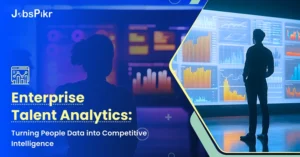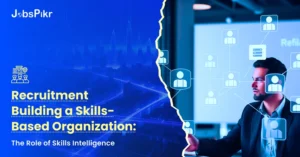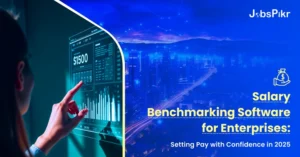As the pace of workplace change accelerates, companies are rethinking how they hire, grow, and retain their people to stay competitive and adaptable. With skills becoming obsolete faster than ever, hybrid workforces becoming the norm, and employee expectations shifting, traditional HR models are being replaced by dynamic, data-driven talent management strategies. These shifts are being fueled by key talent management trends that emphasize agility, personalization, and long-term workforce sustainability.
In this comprehensive article, we’ll explore the most critical trends in talent management shaping 2025 and beyond. From using HR analytics to predict leadership potential to creating scalable frameworks for career mobility and engagement, we’ll break down how enterprise leaders can build resilient, future-ready teams. Whether you’re a CHRO, HR strategist, or L&D professional, these insights will equip you to transform your talent operations through informed, strategic decisions.
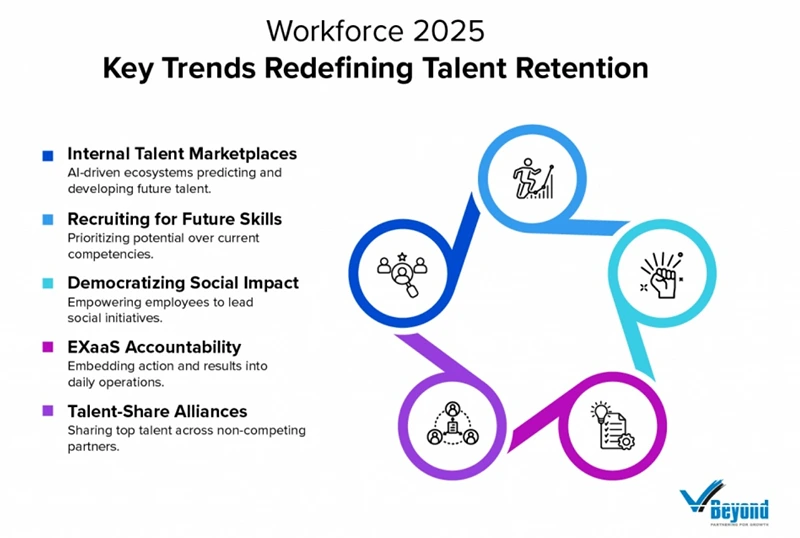
Top Talent Management Trends Reshaping the Workforce in 2025
As workforce expectations evolve and organizations confront talent shortages, agile, forward-thinking talent management strategies are becoming a necessity. Let’s explore the top talent management trends that are shaping how enterprises prepare their people for what’s ahead.
Shift Toward Skills-Based Talent Models
Traditional role-based structures are being replaced by skills-based models, where hiring, development, and promotions are centered around core and adjacent skills. Gartner reports that 56% of HR leaders are restructuring their workforce planning around skills rather than job titles (source).
This approach enables:
- Greater internal mobility
- Personalized development pathways
- Proactive upskilling to close future skill gaps
Increased Use of Talent Marketplaces
Enterprises are investing in internal talent marketplaces—platforms that match employee skills to projects, gigs, and learning opportunities. This empowers employees to own their development and allows organizations to tap into hidden potential.
According to Deloitte, companies that use internal talent marketplaces are 2x more likely to outperform competitors in innovation and employee satisfaction (source).
Emphasis on Workforce Agility
As market demands shift, enterprises need workforces that can adapt quickly. Talent agility means being able to reallocate skills, pivot teams, and reskill employees at scale. Organizations with high workforce agility are 4x more likely to respond effectively to disruption.
Data-Driven Leadership Development
HR analytics are being used to assess leadership readiness, predict promotion success, and measure the impact of development initiatives. High-performing companies are integrating predictive analytics into their succession planning and coaching strategies.
Employee Experience as a Strategic Priority
Modern talent strategies go beyond performance reviews and training modules. Companies are now designing talent experiences that drive engagement, belonging, and retention—from onboarding to career pathing and beyond.
DEI-Driven Talent Strategies
Diversity, equity, and inclusion are no longer just compliance goals. They are central to talent management strategies, influencing hiring practices, development programs, and leadership accountability frameworks. In 2025, DEI outcomes are expected to be integrated into performance dashboards and manager KPIs.
Integration of AI in Talent Management
AI is transforming how HR teams make decisions—from matching employees to projects, to predicting flight risk and learning preferences. AI-powered tools are streamlining career development and personalized learning at scale.
These trends are not only redefining the future of HR, but also reshaping how businesses retain their competitive edge through better talent outcomes.
How Data-Driven Talent Management Strategies Improve Retention and Growth”?
Employee turnover, disengagement, and skill mismatches continue to be major obstacles to business growth. But enterprises that adopt data-backed talent management strategies are better equipped to address these challenges. Leveraging analytics at every stage of the talent lifecycle—from hiring to development—enables organizations to build engaged, future-ready teams while reducing attrition.

Predictive Analytics to Identify Attrition Risk
Data from performance reviews, engagement surveys, learning progress, and absenteeism can be analyzed using predictive models to flag employees at risk of leaving. Companies using this approach report up to 30% reduction in voluntary turnover.
Personalized Learning Paths for Career Growth
By analyzing role-specific skills, learning behaviors, and career trajectories, enterprises can create individualized learning paths that improve performance and retention. L&D platforms powered by data increase employee course completion rates by 2.5x and drive stronger career mobility.
Skills Mapping and Workforce Readiness
Data-driven skills inventories help identify current strengths and gaps across business units. This allows HR to anticipate future needs and plan reskilling programs in advance, creating a more agile and resilient workforce.
Real-Time Feedback and Engagement Monitoring
Sentiment analysis and pulse surveys provide real-time insights into team morale, helping managers take timely action to address burnout, dissatisfaction, or lack of recognition. This builds a continuous feedback loop that improves employee loyalty.
Performance Optimization Through HR Dashboards
Advanced HR analytics platforms offer visual dashboards that track key performance indicators such as goal alignment, team output, and learning ROI. This enables leaders to make smarter resource and promotion decisions.
By embedding analytics into the talent experience, companies not only foster a culture of growth and transparency but also empower employees with the tools and clarity they need to thrive.
The Role of HR Analytics in Workforce Engagement and Leadership Development
HR analytics has moved beyond traditional reporting to become a strategic force behind workforce engagement and leadership pipeline development. By uncovering patterns in employee behavior, development progress, and managerial effectiveness, enterprises are redefining how they nurture and elevate their talent.
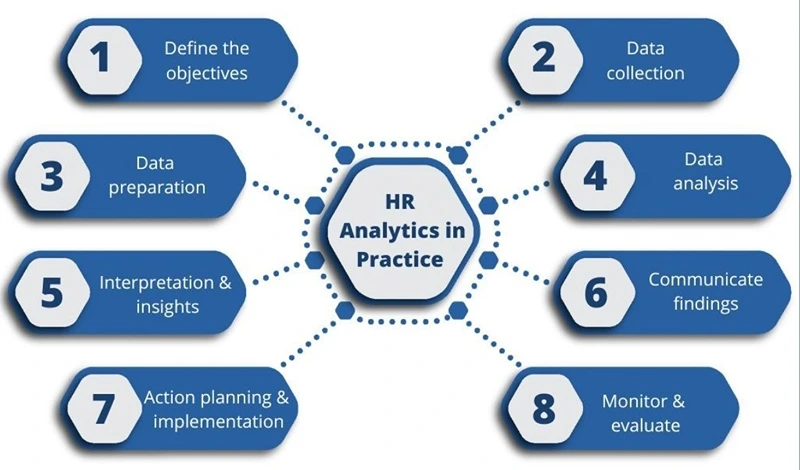
Tracking Employee Engagement with Precision
Modern HR platforms integrate behavioral and attitudinal data to assess engagement. Metrics such as collaboration frequency, learning activity, and sentiment scores help leaders proactively address disengagement. When employees feel heard and supported, retention improves significantly.
Identifying Leadership Potential with Predictive Models
Advanced people analytics can evaluate leadership potential based on communication patterns, decision-making consistency, and peer feedback. Organizations using these models have seen a 25% improvement in internal promotion success rates.
Personalizing Leadership Development
By using analytics to align leadership development with real-time performance data, companies ensure that learning investments are targeted and measurable. Personalized learning journeys and leadership coaching mapped to strengths and gaps result in faster growth trajectories.
Empowering Managers with People Intelligence
Frontline and mid-level managers are now equipped with dashboards that provide team health insights, engagement trends, and talent risk alerts. This empowers them to lead with empathy and data, improving both team cohesion and individual development.
The integration of HR analytics into engagement and leadership development is not just a trend—it’s a transformation. With the right analytics tools and frameworks, enterprises can unlock their full leadership potential while fostering a culture of accountability, transparency, and growth.
Best Practices for Creating a Scalable Talent Management Framework for Enterprises
Building a talent management framework that scales with business growth and evolving workforce needs is essential for modern enterprises. Below are the core best practices that organizations should adopt to ensure their talent management strategy is future-proof, agile, and employee-centric.
Align Talent Strategy with Business Objectives
A successful talent management strategy must be aligned with broader organizational goals. HR leaders should collaborate with business units to map talent requirements to key growth initiatives, such as market expansion, product innovation, or digital transformation. This alignment ensures HR is driving measurable business outcomes
Standardize Yet Personalize
While it’s important to maintain standardized processes for consistency, frameworks must allow for personalization. Tailoring development plans, career paths, and engagement strategies based on individual employee data enhances retention and improves productivity
Foster a Culture of Continuous Feedback
Integrate tools that enable real-time, two-way feedback across the organization. Empower employees to contribute insights and managers to respond quickly. Continuous feedback loops promote engagement and ensure the framework evolves with employee needs
Implement Scalable Learning Ecosystems
A scalable learning system supports growth across all levels. Combine on-demand content, AI-driven course recommendations, mentorship programs, and career mobility tools to build a holistic L&D environment. Enterprises with strong learning cultures are 92% more likely to innovate and adapt.
Integrate Workforce Analytics and Dashboards
Real-time dashboards should provide visibility into critical workforce KPIs, such as skill readiness, retention risk, engagement metrics, and succession health. Use predictive modeling to adjust hiring plans, optimize internal mobility, and measure program ROI
Create an Inclusive Leadership Development Pathway
Design leadership development programs that are inclusive of diverse talent pools and support varied career aspirations. Use data to identify high-potential individuals early and offer rotational roles, peer learning, and strategic coaching to prepare future leaders
Embrace Cross-Functional Talent Collaboration
Break down silos by encouraging departments to share talent. Internal gigs, rotational programs, and cross-functional mentoring improve collaboration and resource utilization, while helping employees broaden their skillsets and stay engaged.
Prioritize Agility Over Hierarchy
Rigid organizational hierarchies often stifle innovation. Design frameworks that prioritize project-based teams, agile collaboration, and flexible reporting lines. This ensures the talent model adapts quickly to new opportunities and market demands.
A scalable framework isn’t just about tools or platforms—it’s about building a culture of adaptability and alignment. When enterprises invest in structure, data, and experience, they create an ecosystem that supports growth, performance, and retention.
How to Future-Proof Your Talent Strategy with Continuous Innovation
To remain competitive and relevant, enterprises must treat talent management not as a static system but as a living, evolving process. Future-proofing your talent management strategy means embracing a mindset of continuous improvement, experimentation, and readiness to pivot in response to change.
Institutionalize a Culture of Learning
Companies must foster an environment where employees are encouraged to continuously reskill and upskill. This involves offering accessible learning opportunities, recognizing learning achievements, and linking development to career growth. Learning-centric organizations outperform their peers in innovation by 46% (source).
Invest in Workforce Intelligence Platforms
Adopting advanced analytics tools and AI-based platforms allows organizations to forecast workforce needs, track emerging skill demands, and assess gaps in real time. These tools make workforce planning more dynamic and proactive.
Promote Design Thinking in HR
Design thinking encourages HR leaders to place employees at the center of problem-solving. Using design-thinking workshops to reimagine onboarding, development, and internal mobility helps tailor experiences to the evolving needs of the workforce.
Reimagine Organizational Structures
Traditional hierarchies are being replaced with flatter, more project-based structures. Embrace agile talent teams, fluid roles, and collaborative work systems to unlock flexibility and faster response to business changes.
Build External Talent Ecosystems
Partner with academic institutions, EdTech platforms, freelance marketplaces, and skill-based communities. This extended ecosystem supports dynamic workforce needs, supports hard-to-fill roles, and diversifies access to emerging talent.
Measure and Iterate Frequently
Define key success metrics for every talent initiative—engagement, mobility, skills acquisition, leadership readiness—and track them consistently. Use quarterly reviews and HR sprints to refine approaches based on what’s working.
Future-proofing your talent approach doesn’t require reinventing the wheel. It requires a willingness to adapt, stay informed, and be bold in shaping new workforce possibilities.
The Road Ahead for Enterprise Talent Management
Agile, data-driven talent management is no longer optional—it’s a competitive imperative. As the labor market grows more complex and unpredictable, enterprises must ground their strategies in real-time job market insights, personalized development, and scalable frameworks that evolve with the business.
The convergence of technology, analytics, and employee-centric design is shaping the future of work. Organizations that embrace these talent management trends and create resilient, adaptable systems will be best positioned to attract, develop, and retain the right people.
Whether you’re revamping an outdated model or scaling a high-growth workforce, now is the time to elevate your talent management strategy for long-term success.Sign up with JobsPikr to access cutting-edge talent insights, workforce data, and market signals that power agile talent strategies at scale.

